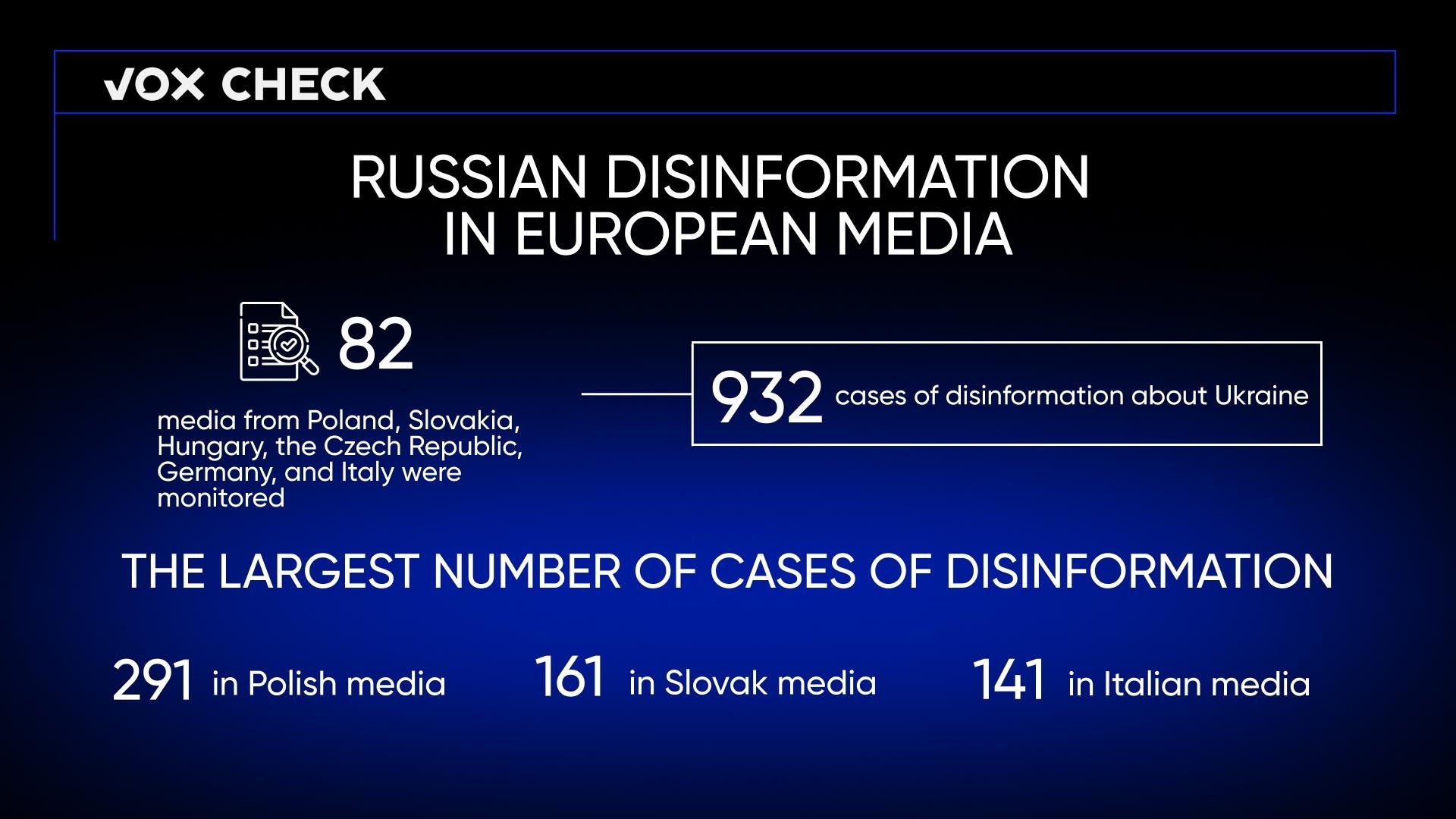In April 2023, VoxCheck monitored media outlets from Poland, Slovakia, Hungary, Czech Republic, Italy, and Germany and identified 932 cases of disinformation about Ukraine. The largest number of disinformation cases were found in Polish (291), Slovakian (161), and Italian (141) media. In April, European media outlets were most active in promoting narratives about Western control over Ukraine, discrediting the Ukrainian government, justifying Russian aggression, and spreading accusations of Ukraine in Nazism and terrorism.
VoxCheck monitors the media in European countries (Germany, Italy, the Czech Republic, Slovakia, Poland, and Hungary) and analyzes the disinformation narratives about Ukraine spread by these media. For the most part, the detected fakes and manipulations are consistent with the main narratives of russian disinformation campaigns. Every month, the VoxCheck team publishes a report on the monitoring results. All disinformation messages, grouped into narratives and their refutations, will be displayed on the “Propaganda diary” database website.
Poland
Polish media, which were included in the monitoring, remain leaders in the amount of disinformation about Ukraine. During the monitoring of 11 media outlets, we identified 291 cases of disinformation, which were grouped into 21 narratives. The most cases were in narratives about Nazism in Ukraine (39 cases), Western control over Ukraine (37 cases), and Ukrainian refugees (30 cases).
“Nazism in Ukraine” continues to be one of the most persistent narratives of pro-Russian propaganda in Europe. Moreover, fakes that were relevant before the full-scale Russian invasion are mostly used for its promotion: the glorification of Nazism in Ukrainian education, the cult of Stepan Bandera, who is called a “Nazi criminal,” repression of the opposition and Russian-speaking population in Ukraine, and the creation of “Nazi battalions” as part of the Ukrainian army. Also, against the background of the full-scale invasion, at least two disinformation messages appeared: calls to European governments to stop supporting the “Nazi state” in the war against Russia and accusations of Ukrainian refugees spreading Nazi ideas in EU countries. Finally, all fakes about Nazism lead to open support of Russian aggression: within this narrative, calls for the denazification of Ukraine and statements about the inadmissibility of the victory of “Nazi Ukraine” in the war are sounded.
“There would be no war in Ukraine if the West in the broadest sense, led by the USA, actively and honestly joined the peace process after the success of Volodymyr Zelenskyi in the 2019 elections”, that’s how Polish media wanted to convince their readers that the West is to blame for Russian aggression. Within the narrative of Western control over Ukraine, reports were actively spread that the West is forcing Ukraine to go to war, to escalate the conflict to weaken Russia, or to test the latest Western weapons. Moreover, the West was accused of plans to appropriate Ukrainian resources after the end of the war.
Since Poland has hosted the largest number of Ukrainian refugees, disinformation about refugees is often most widespread in Polish media. Firstly, the media tried to downplay the scale of the problem and claimed that most Ukrainian refugees come from western and central regions of Ukraine, which allegedly did not feel the effects of the war and have enough resources to provide for their own population. Refugees were also referred to as privileged individuals who abuse the help of EU countries and hinder Poland from taking care of its own citizens, as the Polish government allegedly did more for refugees in 4 weeks than for Poles in 7 years. Secondly, refugees are demonized: they are called Nazis, criminals, and terrorists who cross EU borders without any obstacles.
Another widespread narrative is “Poland seeks to occupy part of Ukraine” (17 cases), which consists of repeating fake news about Poland’s expansionist plans. Such rumors were particularly actively spread at the beginning of April when Volodymyr Zelenskyi was visiting Warsaw and emphasizing the development of relations with Poland.
Slovakia
As a result of monitoring 13 media in Slovakia, we found 161 cases of disinformation, which can be divided between 21 narratives. Narratives about the discrediting of the Ukrainian government (20 cases), Western control over Ukraine (16 cases), and war crimes allegedly committed by Ukraine (12 cases) were the most widespread.
As in previous months, the main target of discredit was the President of Ukraine. According to propagandists in Slovak media, a popular uprising against the President will soon begin due to the continuation of the war and the decline in living standards. Moreover, the West seems to already have a “replacement” for Zelensky — the current Commander-in-Chief of the Armed Forces of Ukraine Valerii Zaluzhnyi. To discredit the government, fabricated news is also used, such as the fake about a “cartoon by French animators” in which Zelenskyi is called a drug addict, a puppet, and a corrupt official, or the “news” about the proposal to ban filming in cemeteries in the Verkhovna Rada to hide military losses. In addition, publications continue to refer to unreliable sources, such as the article by Seymour Hersh, an American journalist who, citing “anonymous sources,” spoke about $400 million of Western aid embezzled by the Office of the President.
To promote the narrative of Western control over Ukraine, both old and new fakes and manipulations are used. Among the old attacks, one should note the fakes about Ukraine being used as a tool by the West to weaken Russia, to stir up the war by the West to maintain its own hegemony in the world, and the Revolution of Dignity, which they try to present as a state coup organized by Victoria Nuland or other representatives of the United States. Among the new attacks, it is necessary to first mention the words of Hungarian Prime Minister Viktor Orban, who claimed that Ukraine as a state does not exist from a financial point of view since all its expenses are financed by the US or the EU. Pro-Russian sources used this quote to reinforce the argument of “external management of Ukraine.”
The narrative about Ukraine’s war crimes mostly consisted of unfounded allegations that the Armed Forces of Ukraine are killing civilians in the occupied territories. In particular, in Bakhmut, by blowing up multi-story buildings. The fake story that rocket attacks on cities controlled by Ukraine were “actually” self-inflicted using missile defense systems was also spread. American pro-Russian sources helped to popularize this narrative in European media, for example, journalist Randy Crediko, who talked about “civilian terror” in Donetsk, or an ex-member of the International Legion who switched to the Russian side.
In April, in anticipation of the Ukrainian army’s offensive, the narrative “Ukrainian victory is impossible” was spread (11 cases). Within this narrative, it was claimed that the morale of Ukrainian defenders is constantly declining, losses of the Armed Forces of Ukraine exceed those of Russia, and the Ukrainian army itself will soon collapse under the pressure of the aggressor.
Hungary
We monitored 14 Hungarian media, found 140 cases of disinformation, and distributed them among 20 narratives. Narratives about the justification of Russian aggression (22 cases), historical events (14 cases), and war crimes of Ukraine (11 cases) became the most widespread.
In the Hungarian media, Russian aggression was justified using the classic set of Russian propaganda clichés: the danger of NATO expansion as a “threat to Russia,” the need to protect the population of Donbas from “genocide,” and Russia’s preventive attack as a response to “Ukraine’s preparation for the capture of Donbas”. The development of Ukrainian nuclear weapons, allegedly announced by Zelenskyi at the Munich Conference in 2022, was also mentioned. Another classic justification is Ukraine’s violations of the Minsk agreements. To promote this fake news, they manipulate comments about the Minsk agreements as a “format that allowed Ukraine to prepare for war with Russia,” which Angela Merkel, Francois Hollande, and Petro Poroshenko allegedly gave at different times. In reality, none of these politicians claimed that Ukraine violated peaceful conditions.
The narrative about historical events was composed of fakes, the purpose of which is to undermine trust in Ukraine and call into question the independence and sovereignty of Ukraine. For example, the fakes about the “historical unity of fraternal peoples” of Ukraine, Belarus, and Russia, who should live in peace, were repeated. “The coup in 2014“, “the expression of the will of the peoples of Crimea and Donbas“, and “the traditionally Russian Crimea” — disinformation that arose in 2014, remains as dangerous in Hungarian media in 2023. In addition, Ukraine was openly called an artificial state, and various states, including Russia, have historical rights to its territory.
To cover up their own war crimes, Russian propaganda usually creates a “smokescreen” by spreading baseless accusations against other countries. This also happened with Hungarian media: repeating what Russian media said, they claimed that Ukraine was responsible for the deaths of civilians and the destruction of civilian infrastructure in the occupied territories of the Zaporizhzhia, Kherson, and Donetsk regions. To emotionally influence the audience, some authors emphasized the shelling of civilians during holidays, such as Easter, thus implying the “inhumanity” of the Ukrainian military.
The narrative “European countries seek to divide Ukraine” (10 cases) also became widespread in the Hungarian information space. Mostly, Poland was called the main “contender” for Ukrainian territories, but in some articles, they also talked about the annexation plans of Romania or Hungary regarding Ukraine.
Czechia
As part of monitoring 12 Czech media in April, we discovered 125 cases of Russian disinformation and 20 narratives. We highlighted the most messages within the framework of narratives about the discrediting of the Ukrainian government (26 cases), the justification of Russian aggression (22 cases), and Western control over Ukraine (17 cases).
In the narrative about the discrediting of the Ukrainian government, the main target of information attacks became the President of Ukraine. Outraged that Volodymyr Zelenskyi and the Ukrainian people were awarded the International Charlemagne Prize, pro-Russian media in the Czech Republic resorted to propaganda. In particular, they called the President of Ukraine an “absolute failure” and an “American king” whose empire supposedly does not expand but contracts. The media summed up that it would be better to give the award to Vladimir Putin, since his empire is constantly “expanding”. In another article, it was claimed that Zelenskyi was following “Boris Johnson’s orders to fight to the last Ukrainian”. That is, the fight against Russian aggression is presented in propagandist media as the Ukrainian leaders carrying out the will of the West.
To justify the Russian invasion, propaganda media in the Czech Republic write that the Russians wanted to “protect” the self-proclaimed “DPR” and “LPR” from “genocide” by Ukraine. The media also spread a statement by Douglas McGregor, an American propagandist and retired US Army colonel, that the Russian invasion is justified because the US had been “preparing” the Ukrainian army for eight years specifically to attack Russia. In addition, the articles contained accusations against the US and NATO, who supposedly take a direct part in the war by supplying weapons to Ukraine.
Once again, Czech pro-Russian media outlets are fueling a narrative about the so-called “control of the West over Ukraine”. Several media outlets write that the “real” goal of the West is to destroy Russia, not to protect Ukraine. Internet resources add that Washington has organized a religious split in Ukraine. To do this, the United States allegedly influences Ukraine’s religious policy through its special representative for religious freedom and the International Religious Freedom Commission. One of the main beneficiaries of the war is also said to be American business, which is soon to buy up all property in Ukraine, as Ukraine will only be able to pay off its huge debts in this way after the war.
To sow distrust of the West among Ukrainians, propagandists are once again talking about the alleged resale of Western weapons by Ukraine (1 case). The media referred to a so-called “foreign mercenary” from the United States who talks about the Ukrainian “criminal scheme” of selling Western weapons. To finally discredit Ukraine, disinformation agents also spread a narrative about the “black transplantology industry” (1 case), which supposedly operates in the Kharkiv region.
Germany
We found 74 cases of disinformation and 25 narratives corresponding to these cases in 19 German media. Most cases were within the framework of narratives about Ukraine as a terrorist state (13 cases), Ukrainian refugees (8 cases), and discrediting the Ukrainian government (6 cases).
The murder of Vladlen Tatarsky, a pro-Russian propagandist and collaborator, in April became the main event through which German media tried to portray Ukraine as a terrorist state. The media unconditionally wrote that Ukraine was responsible for the murder, and that the US and EU allegedly contributed to the “emergence” of a terrorist state in the center of Europe. Terrorism is also mentioned in the context of the activities of “Ukrainian sabotage groups in Russian territory” and the explosion on the Crimean Bridge in October 2022. It is also possible to find predictions that the future Ukrainian offensive will inevitably be accompanied by an increase in terrorist attacks. These information attacks also have practical application: propagandists call for Ukraine to be recognized as a terrorist regime or a sponsor of terrorism.
Despite targeting the German audience, in April, German media spread more fakes and manipulations about Ukrainian refugees in other EU countries. For example, in publications it was written that Poland and Baltic countries are “shocked” by the behavior of Ukrainians, who do not want to learn foreign languages, respect local traditions, and work. In general, Ukrainian refugees are called privileged compared to refugees from other countries, as they supposedly receive more assistance and attention. Refugees are also accused of the fact that the uncontrolled flow of migrants has led to an increase in the number of criminals and terrorists in the EU. Thus, in propaganda materials, the acceptance of Ukrainian refugees is called an “anti-European act”.
The narrative component about the discrediting of the Ukrainian government is the statement “the government is willing to fight to the last Ukrainian”. This time, the media came up with the claim that the Ukrainian Ambassador to Great Britain, Vadym Prystaiko, confirmed Ukraine’s desire to fight to the last Ukrainian. Furthermore, fakes could be noticed in articles claiming that the Ukrainian government is willing to “trade” territories, for example, to return Crimea in exchange for Poland’s occupation of western regions of Ukraine. It has become traditional to accuse Ukraine of an extremely high level of corruption, stating that even representatives of the EU admit that Western aid is not being used for its intended purpose and does not reach Ukrainian citizens.
In addition, in April, the following narratives gained popularity in German media: the Ukrainian army commits war crimes (6 cases), Europeans are protesting against the provision of weapons to Ukraine (4 cases), and the Orthodox Church is being persecuted in Ukraine (4 cases).
Italy
In April, we discovered 141 cases of disinformation in 13 Italian media. We divided all cases into 25 narratives, the largest of which are Russia’s war with NATO or the “collective West” (14 cases), Western control over Ukraine (14 cases), Ukraine as a terrorist state (13 cases).
To justify a series of military defeats and the prolongation of the war, pro-Russian propaganda spreads the narrative that “Russia is at war with NATO or the West, but not with Ukraine”. To prove this, they point out Ukraine’s dependence on Western military supplies and assert that the Ukrainian Armed Forces would not have survived without this support. They also use openly invented stories, such as the claim that all Ukrainian military operations are planned in NATO headquarters, the presence of American military personnel in the ranks of the Ukrainian army, or how Russia destroyed a “secret bunker with NATO officers” in Lviv Oblast with a missile strike. According to disinformation agents, the goal of the “West’s war against Russia” is not only to weaken Russia but also to divide and occupy Russian territories.
In the Italian media, which are being monitored, there is a belief that the Russian-Ukrainian war was provoked by the US to isolate Europe from Russia. In addition, Western control over Ukraine is considered in the context of American-Chinese confrontation: allegedly, the US will use Ukraine as it will use Taiwan, as a tool to weaken its opponent. Propagandists believe that the continuation of the war is beneficial to Western bankers and transnational corporations, which form the basis of the “deep state” in the US and seek to maximize profits. At the same time, within the framework of this narrative, apocalyptic predictions are spread, warning that the “West’s proxy war in Ukraine” could turn into a nuclear war.
Just like in German media, Italian media also used the murders of Vladlen Tatarskyy and other Russian propagandists as a pretext to accuse Ukraine of terrorist acts. They also frequently quoted representatives of Russia, such as Kremlin spokesman Dmitry Peskov, who claimed that Ukraine had been engaged in terrorism since 2014. The narrative of terrorism is often attempted to be linked to the narrative of Western control over Ukraine — as if all “attacks” by Ukraine are carried out on the instructions of the US or other Western countries.
In April, Italian media also spread the narrative “Ukraine threatens with a nuclear catastrophe” (6 cases). The first fake within this narrative was the transfer of uranium shells by Britain to Ukraine, which allegedly would lead to a catastrophe similar in scale to the Chornobyl tragedy. The second fake is related to the shelling of the Zaporizhzhia Nuclear Power Plant, in which pro-Russian sources accuse Ukrainian forces.
Attention
The authors do not work for, consult to, own shares in or receive funding from any company or organization that would benefit from this article, and have no relevant affiliations



